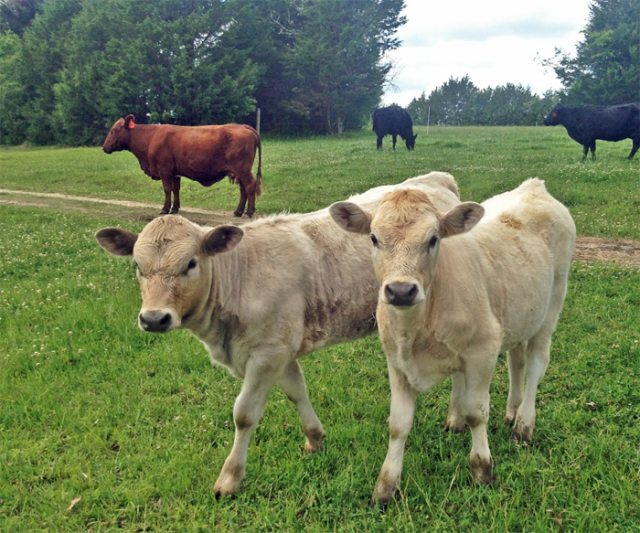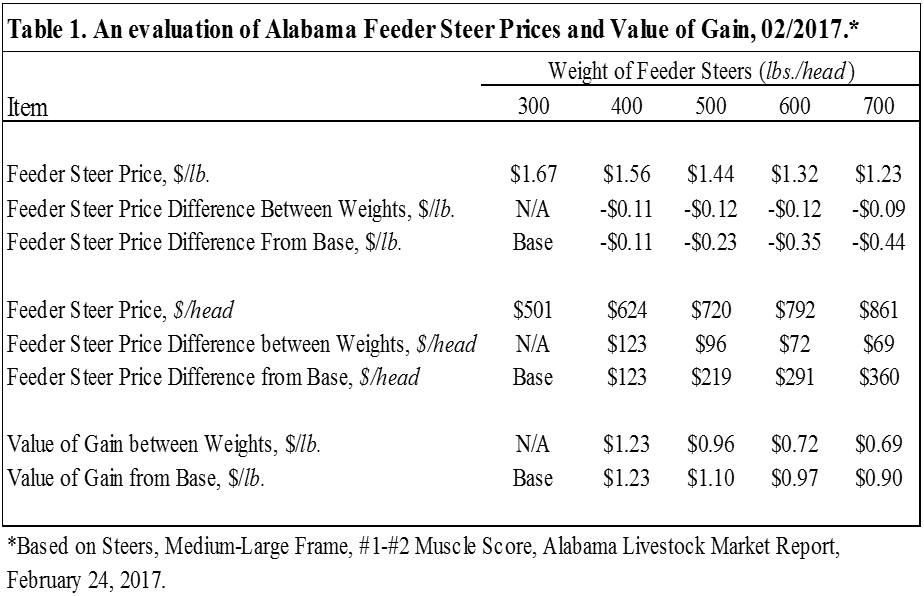Best Weight to Sell Beef Cattle

Should you sell light-weight feeder calves now or hold them and sell them when they are heavier?" The answer to this question depends on a number of factors that must be analyzed. Photo credit: Chris Prevatt
Chris Prevatt, UF/IFAS Livestock Economics Regional Agent
A commonly asked question around sale barns and at extension programs is " Should I sell light-weight feeder calves now or hold them and sell them when they are heavier? " The answer to this question depends on your individual situation. A number of factors including market prices going forward, value of gain, cost of gain, labor availability, forage and feed situation, and condition of the brood cows must be included in the analysis.
Since Florida no longer has a state market reporting system, let's take a look at a recent Alabama Livestock Market Report and evaluate feeder calf market prices, and the price differences between feeder steers of different weights. Table 1 describes the auction market price as reported by USDA, Alabama Livestock Market Report, on February 24, 2017. The feeder steer prices beginning with the 300-pound steer calf, when expressed as dollars per pound, was the highest at $1.67/lb.  Typically, overall feeder calf value increases as weight increases, and price per pound decreases as weight increases. From Table 1 you can see that the lowest price per pound was reported for the 700-pound feeder steers, at $1.23 per pound. Alternatively, when feeder steer prices are expressed as dollars per head, the 300-pound feeder steer value was the lowest at $501 per head. The highest value was $861 per head for the 700-pound feeder steer. Last week's market report shows how feeder steer values expressed in dollars per head basis increases as weight increases ($501, $624, $720, $792, and $861 for the respective weights)
Typically, overall feeder calf value increases as weight increases, and price per pound decreases as weight increases. From Table 1 you can see that the lowest price per pound was reported for the 700-pound feeder steers, at $1.23 per pound. Alternatively, when feeder steer prices are expressed as dollars per head, the 300-pound feeder steer value was the lowest at $501 per head. The highest value was $861 per head for the 700-pound feeder steer. Last week's market report shows how feeder steer values expressed in dollars per head basis increases as weight increases ($501, $624, $720, $792, and $861 for the respective weights)
Table 1 provides some extra information that is not commonly reported with market reports. It shows the price differences for both the price per pound, and price per head in 100 pound increments of feeders steers sold in Alabama last week. Interestingly the price difference per head changes between weight categories varies widely and ranged from $69 to $123 per head. Thus, if you can add 100-pounds of gain for less than $69 per head, adding weight will be profitable for all weight categories. Most cow-calf producers can add weight to 300-pound and 400-pound feeder calves without incurring significant costs, since these calves are nursing and grazing on pasture. Some producers can add weight to 500-pound feeder calves without spending more than the gain in value. However, most producers will incur some additional costs to add 100-pounds of gain to 600-pound calves for supplemental feed and care after weaning. The key question to answer is, " Can you add 100 pounds for less expense than the change in total value of the calf? " There are additional costs incurred for each increase in weight. If the additional costs per head to gain 100-pounds are going to exceed the market price difference per head (additional value of gain), you need to sell the feeder calves. Also, producers need to understand the price difference calculated above ($69 to $123 per head for each additional 100-pounds of gain) varies with changing market conditions. In general, the value of gain on 300-400 pound calves tends to be higher than for 500-600 pound calves.
Use the light-weight feeder steers as a base to view the price differences as you add weight to various endpoints. This measurement is commonly used by stocker operators. The feeder steer price difference per pound between the 300-pound (base) and 700-pound feeder steers for example was -$0.44 per pound. However, when expressed on a dollars per head basis the feeder steer price difference from the base was $360 per head ($861 – $501). This says that the market as of February 24, 2022 valued 400-pounds of additional gain at $361 per head. Unfortunately, these values are constantly changing as different factors of supply and demand influence the market, so you have to evaluate this regularly as you prepare to market your calves.
Using the information above, the value of gain between weights can be expressed in dollars per pound between each weight category. The value of gain between 300 and 400-pound feeder steers was $1.23 per pound. The value of gain between weight categories ranged from $0.69 to $1.23 per pound of gain. Thus, if you can add weight for less than $0.69 per pound of gain, then this is a profitable decision to add weight for all weight categories. Likewise, the value of gain from the base of the 300-pound feeder steers to each successive weight category allows you to evaluate the value for various endpoints. The value of gain from the base ranged from $0.90 to $1.23 per pound of gain. Again, if you can add weight gain for less than $0.90, you would sell the 700-pound feeder steer. Please note that the value of gain "is not" the same as the market price in the examples in Table 1. The only time the value of gain per pound "would be equal" to the market price per pound is when there is no difference in the price per pound between different weights of feeder calves (300 and 400-pound calves would have to sell for the same price per pound).
This spot-market analysis documents that the calves with the greatest value are actually the heavier calves. The question that each cattle producer has to answer is " Will it be profitable to add additional weight and sell heavier feeder calves? " Evaluating the costs and returns for each incremental increase of 100-pounds of weight gain will help you decide when to pull the trigger to send calves to market. In general, it is more profitable to keep nursing calves with their mothers longer to add weight. Once calves are weaned, however, then you really have to calculate the cost of gain compared to the current market to make this decision.
——
[important]If you would like to receive a weekly Alabama cattle market summary report called the "Alabama Weekly Livestock News" by e-mail each Friday, send your e-mail address to Diana.Drummond@ams.usda.gov or call the office at (334)-240-7289 or (334)-223-7488 and they will add you to their e-mail list.
You can also access the weekly report online at https://www.ams.usda.gov/mnreports/lswalabama.pdf[/important]
- Author
- Recent Posts
Source: https://nwdistrict.ifas.ufl.edu/phag/2017/03/03/at-what-weight-should-i-sell-my-feeder-calves/
0 Response to "Best Weight to Sell Beef Cattle"
Post a Comment